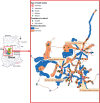Evaluating the implementation of community volunteer assessment and referral of sick babies: lessons learned from the Ghana Newhints home visits cluster randomized controlled trial
- PMID: 25274636
- PMCID: PMC4202912
- DOI: 10.1093/heapol/czu080
Evaluating the implementation of community volunteer assessment and referral of sick babies: lessons learned from the Ghana Newhints home visits cluster randomized controlled trial
Abstract
A World Health Organization (WHO)/United Nations Children's Fund (UNICEF) (2009) joint statement recommended home visits by community-based agents as a strategy to improve newborn survival, based on promising results from Asia. This article presents detailed evaluation of community volunteer assessment and referral implemented within the Ghana Newhints home visits cluster-Randomized Controlled Trial (RCT). It highlights the lessons learned to inform implementation/scale-up of this model in similar settings. The evaluation used a conceptual framework adopted for increasing access to care for sick newborns and involves three main steps, each with a specific goal and key requirements to achieving this. These steps are: sick newborns are identified within communities and referred; families comply with referrals and referred babies receive appropriate management at health facilities. Evaluation data included interviews with 4006 recently delivered mothers; records on 759 directly observed volunteer assessments and 52 validation of supervisors' assessments; newborn care quality assessment in 86 health facilities and in-depth interviews (IDIs) with 55 mothers, 21 volunteers and 15 health professionals. Assessment accuracy of volunteers against supervisors and physician was assessed using Kappa (agreement coefficient). IDIs were analysed by generating and indexing into themes, and exploring relationships between themes and their contextual interpretations. This evaluation demonstrated that identifying, understanding and implementing the key requirements for success in each step of volunteer assessment and referrals was pivotal to success. In Newhints, volunteers (CBSVs) were trusted by families, their visits were acceptable and they engaged mothers/families in decisions, resulting in unprecedented 86% referral compliance and increased (55-77%) care seeking for sick newborns. Poor facility care quality, characterized by poor health worker attitudes, limited the mortality reduction. The important implication for future implementation of home visits in similar settings is that, with 100% specificity but 80% sensitivity of referral decisions, volunteers might miss some danger signs but if successful implementation must translate into mortality reductions, concurrent improvement in facility newborn care quality is imperative.
Keywords: Assessment and referral; community; implementation; newborns.
Published by Oxford University Press in association with The London School of Hygiene and Tropical Medicine © The Author 2014; all rights reserved.
Figures
References
-
- Awasthi S, Srivastava NM, Pant S. Symptom-specific care-seeking behavior for sick neonates among urban poor in Lucknow, Northern India. Journal of Perinatology. 2008;28:S69–75. - PubMed
-
- Azad K, Barnett S, Banerjee B, et al. Effect of scaling up women's groups on birth outcomes in three rural districts in Bangladesh: a cluster-randomised controlled trial. Lancet. 2010;375:1193–202. - PubMed
-
- Bang AT, Bang RA, Baitule SB, Reddy MH, Deshmukh MD. Effect of home-based neonatal care and management of sepsis on neonatal mortality: field trial in rural India. Lancet. 1999;354:1955–61. - PubMed
-
- Bang AT, Bang RA, Stoll BJ, et al. Is home-based diagnosis and treatment of neonatal sepsis feasible and effective? Seven years of intervention in the Gadchiroli field trial (1996 to 2003) Journal of Perinatology. 2005a;25:S62–71. - PubMed
-
- Bang AT, Reddy HM, Deshmukh MD, Baitule SB, Bang RA. Neonatal and infant mortality in the ten years (1993 to 2003) of the Gadchiroli field trial: effect of home-based neonatal care. Journal of Perinatology. 2005b;25:S92–107. - PubMed
Publication types
MeSH terms
LinkOut - more resources
Full Text Sources
Other Literature Sources
Medical



